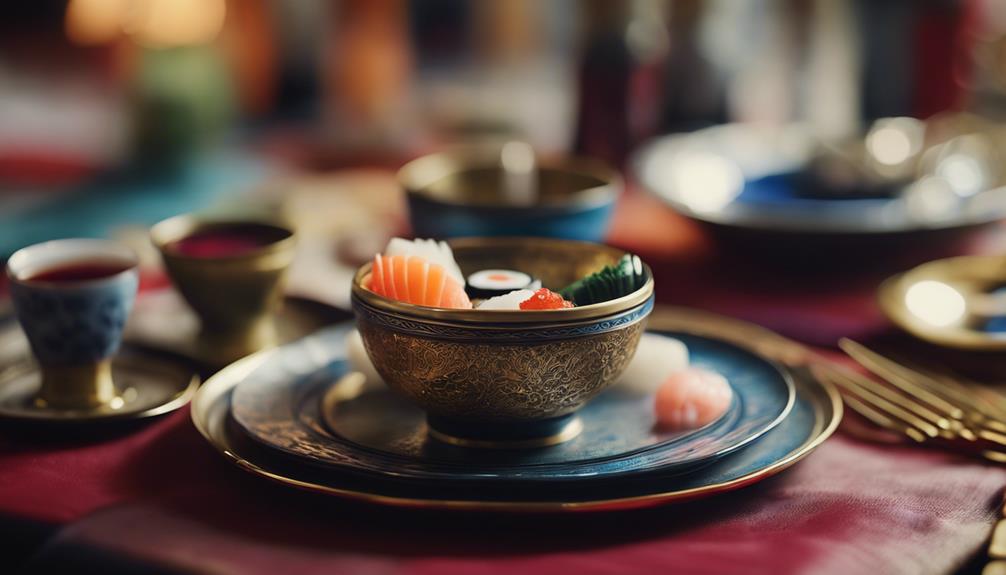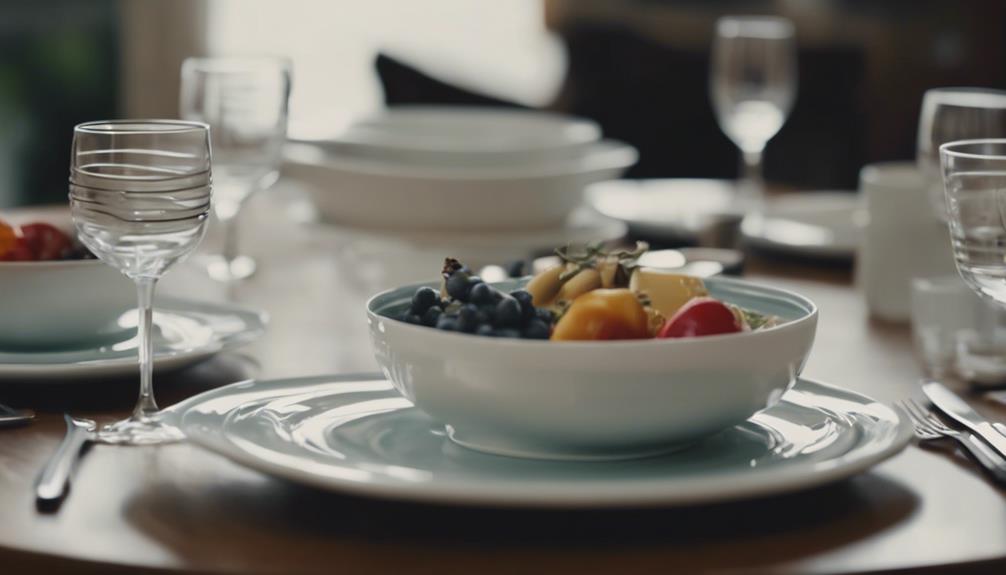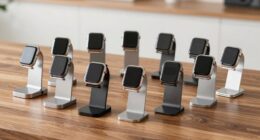Tableware is a collection of dishes, utensils, and items for meals that are essential for both function and aesthetics. It includes dinnerware like plates and bowls, flatware with knives and forks, and drinkware such as glasses. Tableware serves practical and decorative purposes, setting the tone for dining experiences, reflecting style, and enhancing dish presentation. Different materials like porcelain, ceramic, and glass provide distinct characteristics, impacting the dining experience. Cultural influences from around the world shape various tableware styles. A well-coordinated tableware adds sophistication and makes guests feel special. Discover more about the evolution of tableware, materials, and design trends.
Key Takeaways
- Collection of dishes, utensils, and items for meals.
- Practical and decorative table items.
- Includes dinnerware, flatware, drinkware, and servingware.
- Reflects style, enhances presentation, and sets the dining tone.
- Various materials like porcelain, ceramic, and glassware used.
Definition of Tableware

What exactly is tableware and how is it defined?
Tableware refers to the collection of dishes, utensils, and items used during meals. These include plates, knives, forks, and serving dishes, among others.
The term 'tableware' originated in the early 19th century in the United States, combining 'table' and 'ware' to describe dining accessories. This category encompasses a diverse range of materials such as porcelain, ceramic, stainless steel, glassware, and cutlery, all essential for setting a table.
While the primary function of tableware is to serve food, it also adds an aesthetic element to dining experiences. From kitchen utensils to elegant serving platters, tableware serves practical and decorative purposes.
The evolution of tableware showcases the shift from basic wooden and metal items to finely crafted china, demonstrating the fusion of aesthetics and functionality in modern designs.
Types of Tableware

When setting a table for a meal, various types of tableware play essential roles in serving and enjoying food. Dinnerware, which includes plates, bowls, and serving dishes, is vital for presenting meals attractively and facilitating easy dining.
Flatware, such as knives, forks, and spoons, are indispensable tools for enjoying the meal.
Drinkware, comprising glasses, cups, and mugs, is necessary for serving a variety of beverages to complement the food.
Servingware, like platters, trays, and serving utensils, assist in distributing food efficiently to diners.
Additionally, specialized tableware items cater to specific dining needs; for example, tea sets enhance the experience of serving tea, chargers elevate the presentation of formal dining settings, and dessert plates provide a designated space for sweet treats.
These examples don't represent an exhaustive list but showcase the diversity of tableware available to enhance your dining experience.
Importance of Tableware

Tableware plays an essential role in setting the tone for your dining experience. It not only contributes to proper table setting etiquette but also enhances the overall enjoyment of your meals.
Your choice of tableware can reflect your style and elevate the presentation of your dishes.
Table Setting Etiquette
Understanding proper table setting etiquette is essential for creating an enjoyable dining experience for both hosts and guests. Here are three reasons why table setting etiquette is important:
- Enhances Aesthetics: Proper use of tableware can elevate the visual appeal of a meal, making it more inviting and appealing.
- Improves Functionality: Using tableware correctly not only looks good but also guarantees that guests can comfortably enjoy their food and drinks.
- Shows Respect: Following table setting rules demonstrates consideration for others and attention to detail, making guests feel valued and respected during the dining experience.
Enhancing Dining Experience
To enhance the overall dining experience, mastering the art of table setting etiquette is key in creating a welcoming and visually appealing atmosphere for both hosts and guests. The choice of tableware, such as plates, cutlery, and glasses, plays an essential role in setting the tone and ambiance of a meal.
Well-coordinated tableware not only elevates the presentation of food and drinks but also adds a touch of sophistication and elegance to any dining occasion. Additionally, investing in quality tableware reflects attention to detail and can make guests feel special and valued during meals.
Style and Presentation
Enhancing the style and presentation of your dining experience relies heavily on the careful selection of tableware. The importance of tableware in setting the tone for your meal can't be overstated. Here are three reasons why tableware plays an essential role in creating an appealing dining atmosphere:
- Aesthetic Impact: The choice of tableware can greatly influence the overall visual appeal of your meal, making it more inviting and attractive.
- Atmospheric Enhancements: Properly selected tableware can elevate the dining setting, making the experience more enjoyable and memorable.
- Reflects Thoughtfulness: Attention to detail in selecting tableware demonstrates care in hosting guests or simply elevating your own dining experience.
Evolution of Tableware

Tableware has come a long way from its early days of wood and metal, evolving with the advancements in materials like porcelain and ceramic.
The Industrial Revolution played a pivotal role in revolutionizing tableware production, making it more accessible through mass manufacturing.
Understanding the historical development and cultural influences on tableware sheds light on its significance beyond just functionality.
Historical Tableware Development
During the historical development of tableware, early pottery primarily focused on creating pots and jars rather than flatware. This shift in focus led to the evolution of tableware over time, bringing about various changes and improvements.
- Precious Metals: Ancient elites showed a preference for using materials like gold and silver for their flatware, showcasing their status and wealth.
- Medieval Cuisine: Trenchers, which were bread rounds used as plates, were a common sight in medieval dining, reflecting the practicality and resourcefulness of that era.
- Sumptuary Laws: Tableware ownership wasn't just about utility; it was also a symbol of wealth and social status, regulated by sumptuary laws throughout history.
Cultural Influences on Tableware
Cultural influences have played a significant role in shaping the evolution of tableware throughout history. Early tableware was crafted from wood or metal, reflecting the materials available in different regions. The Industrial Revolution revolutionized tableware production, making it more accessible to the masses.
Fine china became a symbol of luxury among the elite, showcasing cultural preferences for elegance and sophistication. In modern times, tableware designs combine aesthetics with functionality, offering a diverse range of styles and materials to suit various cultural tastes. Changes in social norms and design preferences have continuously influenced the evolution of tableware, highlighting the dynamic relationship between culture and dining practices.
Materials Used in Tableware

When selecting tableware, considering the materials used is essential as they dictate the overall aesthetics and functionality of your dining experience. Different materials offer unique characteristics that contribute to the style and practicality of your table settings. Here are some common materials used in tableware:
- Porcelain: Known for its delicate appearance.
- Ceramic: Valued for its durability.
- Glass: Adds elegance to your table.
Each material, whether it be stainless steel, melamine, or others, brings its own set of advantages, making them suitable for various occasions. Understanding these properties can help you choose the right tableware to match your specific needs and preferences. So, whether you prefer the refined look of porcelain, the sturdiness of ceramic, or the sleekness of stainless steel, the material you choose will have a significant impact on your dining experience.
Tableware in Different Cultures

Exploring tableware across various cultures reveals a rich tapestry of designs, materials, and symbolic meanings tied to dining traditions. In Chinese culture, tableware carries symbolic importance, with specific designs and materials tailored for different occasions. Japanese tableware embodies the country's aesthetic values, emphasizing simplicity, elegance, and functionality. Indian tableware showcases a diverse range of materials like brass, copper, and stainless steel, featuring intricate designs suited for both traditional ceremonies and daily use. Middle Eastern tableware stands out with its rich colors, intricate patterns, and motifs influenced by Islamic art and culture, often used in elaborate dining settings. African tableware incorporates natural elements such as wood, clay, and gourds, reflecting a wide array of cultural traditions and artistic expressions in dining practices.
| Culture | Materials | Design Characteristics |
|---|---|---|
| Chinese | Symbolic designs, specific materials | Tailored for different occasions |
| Japanese | Simplicity, elegance, functionality | Reflects aesthetic values |
| Indian | Brass, copper, stainless steel | Intricate designs for ceremonies |
| Middle Eastern | Rich colors, Islamic motifs | Elaborate dining settings |
| African | Wood, clay, gourds | Diverse cultural traditions |
Table Setting Essentials

As you prepare to set the table for your next meal, ensuring the proper placement of cutlery, glassware, and dinnerware is key to creating an inviting dining experience. Here are some essential tips to help you set the table effectively:
- Correct Order: Knowing the correct order of utensils and plates for various courses is important, especially in formal dining settings. Understanding which cutlery to place for each course can elevate the dining experience.
- Table Setting Styles: Different styles of table settings, such as service à la russe or service à la française, dictate the arrangement of tableware. Each style has its unique way of presenting the items on the table, adding a touch of elegance to your dining experience.
- Place Markers and Accessories: Place markers are essential for designating seating arrangements at formal functions and events. Additionally, understanding the role of accessories like serving dishes, butter dishes, and casseroles can enhance the overall dining experience, making your table setting both functional and aesthetically pleasing.
Tableware for Special Occasions

For special occasions, selecting tableware that includes fine china, crystal glassware, and sterling silver flatware can enhance the elegance of your dining experience. These sophisticated pieces add a touch of luxury and refinement to your table setting, creating a memorable atmosphere for your guests.
Special occasion tableware often features elaborate centerpieces, decorative chargers, and linen napkins, further elevating the overall look and feel of the dining arrangement. Whether it's a wedding, a formal dinner, or a holiday celebration, using high-end tableware sets can make the event even more special.
Some special occasion tableware sets are considered heirloom pieces, treasured and passed down through generations, adding sentimental value to the dining experience. The design of special occasion tableware is crafted to create a luxurious ambiance, making your guests feel pampered and enhancing the overall dining experience.
Tableware Trends and Designs

Sustainable tableware options have gained popularity due to environmental concerns and an emphasis on eco-friendly materials. If you're looking to stay trendy in the world of tableware, here are some design movements to keep an eye on:
- Minimalist Designs: Embracing clean lines and simplicity is all the rage, reflecting a contemporary aesthetic that exudes modern charm.
- Personalized Touch: Custom and personalized tableware are on the rise, allowing you to showcase your unique style and preferences with every meal.
- Mix and Match: Mixing different tableware sets is a hot trend, creating a dynamic and eclectic table setting that adds a personalized flair to your dining experience.
Whether you prefer the nostalgia of vintage styles, the sleekness of minimalist designs, or the personal touch of customized pieces, there's a tableware trend to suit every taste and elevate your dining experience.
Frequently Asked Questions
What Is Considered Tableware?
When thinking about what's considered tableware, it typically includes items like dishes, plates, cutlery, and glassware used during meals. These essential pieces for dining can be made from various materials like porcelain, ceramic, glass, stainless steel, or melamine.
Tableware plays a vital role in setting the tone for your dining experience, combining both functionality and aesthetics to enhance your meals.
What Are the Basic Types of Tableware?
When setting your table, keep in mind the basic types of tableware:
- Dinnerware for plates and bowls
- Flatware like knives and forks
- Drinkware such as glasses and cups
- Servingware including platters and utensils
Specialized tableware like tea sets and dessert plates cater to specific dining needs. These essential pieces guarantee your table is set for any occasion, with each item serving a unique purpose to enhance your dining experience.
What Is the Definition of Tableware in Cooking?
In cooking, tableware comprises dishes, utensils, and accessories used for meal preparation and serving. Items like plates, bowls, knives, forks, spoons, glasses, and serving dishes fall into this category.
Various materials such as porcelain, ceramic, stainless steel, glass, and melamine are commonly employed in tableware. Its role is essential in presenting and serving food in an appealing and organized manner, enhancing the dining experience and reflecting the meal's style and theme.
What Is Tableware and Flatware?
When it comes to tableware and flatware, you might wonder what sets them apart. Tableware encompasses all the dishes and serving items, while flatware refers specifically to the knives, forks, and spoons you use to eat.
Understanding these distinctions is essential for proper table setting. Different materials like porcelain, ceramic, and stainless steel are common for tableware and flatware.
Make sure you have the right tools for your next meal!
Conclusion
To sum up, tableware is an essential part of dining that serves both functional and aesthetic purposes. From everyday meals to special occasions, the right tableware can enhance the overall dining experience.
Different cultures have their own unique tableware traditions, and trends in tableware design continue to evolve.
Whether it's a simple dinner at home or a lavish celebration, choosing the right tableware can make all the difference in setting the tone for a memorable dining experience.










